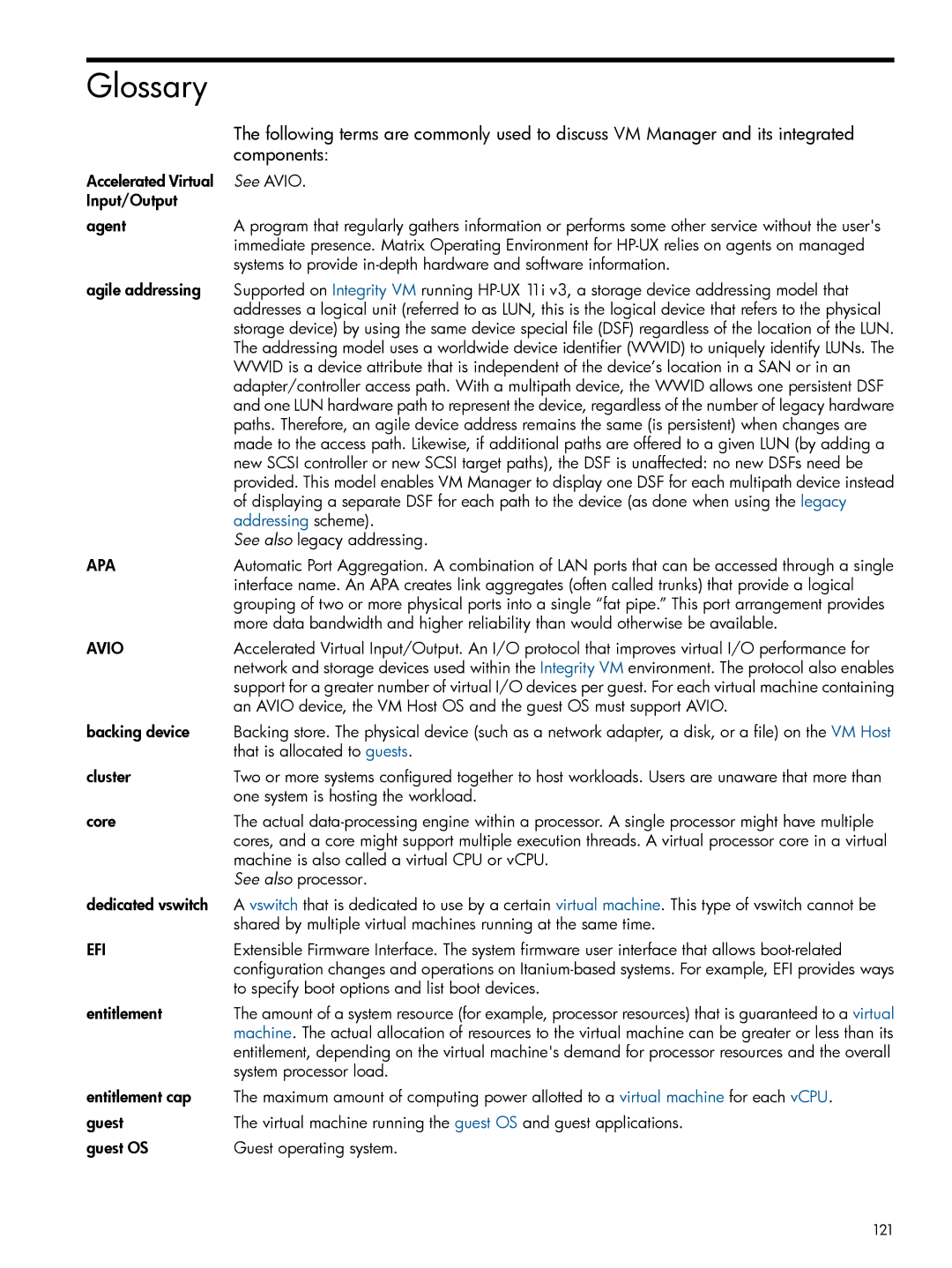Glossary
| The following terms are commonly used to discuss VM Manager and its integrated |
| components: |
Accelerated Virtual | See AVIO. |
Input/Output |
|
agent | A program that regularly gathers information or performs some other service without the user's |
| immediate presence. Matrix Operating Environment for |
| systems to provide |
agile addressing | Supported on Integrity VM running |
| addresses a logical unit (referred to as LUN, this is the logical device that refers to the physical |
| storage device) by using the same device special file (DSF) regardless of the location of the LUN. |
| The addressing model uses a worldwide device identifier (WWID) to uniquely identify LUNs. The |
| WWID is a device attribute that is independent of the device’s location in a SAN or in an |
| adapter/controller access path. With a multipath device, the WWID allows one persistent DSF |
| and one LUN hardware path to represent the device, regardless of the number of legacy hardware |
| paths. Therefore, an agile device address remains the same (is persistent) when changes are |
| made to the access path. Likewise, if additional paths are offered to a given LUN (by adding a |
| new SCSI controller or new SCSI target paths), the DSF is unaffected: no new DSFs need be |
| provided. This model enables VM Manager to display one DSF for each multipath device instead |
| of displaying a separate DSF for each path to the device (as done when using the legacy |
| addressing scheme). |
| See also legacy addressing. |
APA | Automatic Port Aggregation. A combination of LAN ports that can be accessed through a single |
| interface name. An APA creates link aggregates (often called trunks) that provide a logical |
| grouping of two or more physical ports into a single “fat pipe.” This port arrangement provides |
| more data bandwidth and higher reliability than would otherwise be available. |
AVIO | Accelerated Virtual Input/Output. An I/O protocol that improves virtual I/O performance for |
| network and storage devices used within the Integrity VM environment. The protocol also enables |
| support for a greater number of virtual I/O devices per guest. For each virtual machine containing |
| an AVIO device, the VM Host OS and the guest OS must support AVIO. |
backing device | Backing store. The physical device (such as a network adapter, a disk, or a file) on the VM Host |
| that is allocated to guests. |
cluster | Two or more systems configured together to host workloads. Users are unaware that more than |
| one system is hosting the workload. |
core | The actual |
| cores, and a core might support multiple execution threads. A virtual processor core in a virtual |
| machine is also called a virtual CPU or vCPU. |
| See also processor. |
dedicated vswitch | A vswitch that is dedicated to use by a certain virtual machine. This type of vswitch cannot be |
| shared by multiple virtual machines running at the same time. |
EFI | Extensible Firmware Interface. The system firmware user interface that allows |
| configuration changes and operations on |
| to specify boot options and list boot devices. |
entitlement | The amount of a system resource (for example, processor resources) that is guaranteed to a virtual |
| machine. The actual allocation of resources to the virtual machine can be greater or less than its |
| entitlement, depending on the virtual machine's demand for processor resources and the overall |
| system processor load. |
entitlement cap | The maximum amount of computing power allotted to a virtual machine for each vCPU. |
guest | The virtual machine running the guest OS and guest applications. |
guest OS | Guest operating system. |
121
